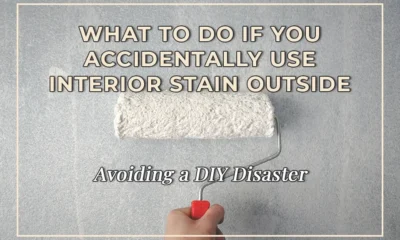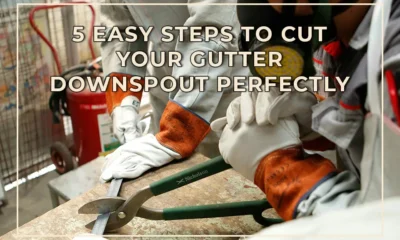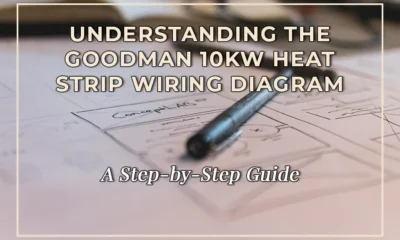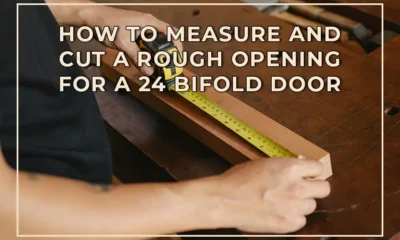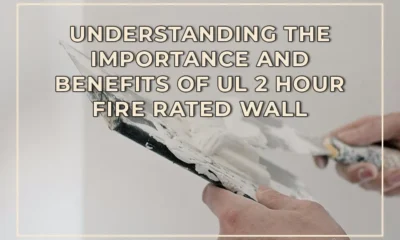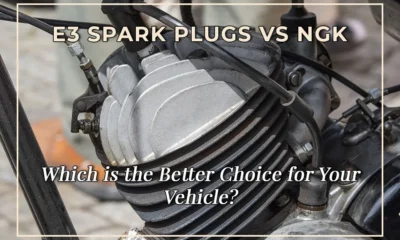DIY Closet
Understanding the Basics: Goodman Electric Heat Strip Wiring Diagram Explained
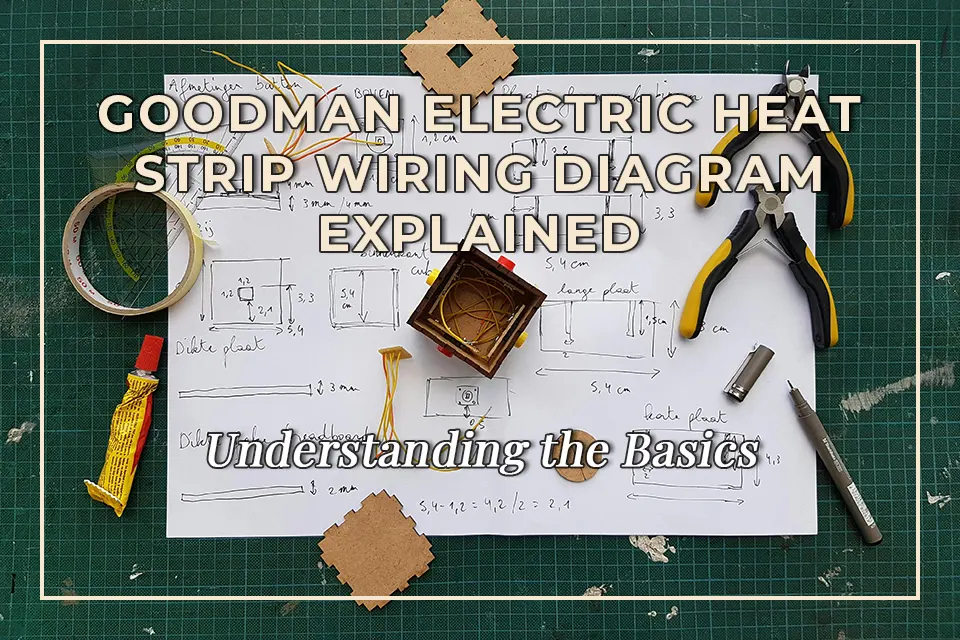
[ad_1]
Are you looking to understand the basics of Goodman electric heat strip wiring diagrams? This article will provide a simple explanation of how these diagrams work, and how you can use them to effectively wire your electric heat strips. By the end of this article, you will have a better understanding of the wiring diagram and be able to apply this knowledge to your DIY projects. Let’s get started!
What is a Goodman Electric Heat Strip Wiring Diagram?
A Goodman electric heat strip wiring diagram is a visual representation of the electrical connections and wiring required for the electric heat strips to function properly. It shows the components of the system and how they are connected, ensuring that the electric heat strips receive the necessary power to produce heat effectively.
The wiring diagram is essential for installing, troubleshooting, and repairing electric heat strips. It provides a detailed overview of the wiring connections, including the power supply, controls, and heating elements. Understanding this diagram is crucial for anyone working with electric heat strips.
How to Read a Goodman Electric Heat Strip Wiring Diagram
Reading a Goodman electric heat strip wiring diagram may seem daunting at first, but with a little guidance, it can become much simpler. The diagram typically includes symbols and labels that represent different electrical components and their connections. By familiarizing yourself with these symbols and understanding the flow of electrical current, you can easily interpret the wiring diagram.
Start by identifying the main components, such as the power supply, thermostat, sequencers, and heating elements. Then, follow the lines and connections to understand how these components are linked together. Pay close attention to the wiring color codes and ensure that the connections align with the manufacturer’s guidelines for a safe and efficient installation.
Common Wiring Diagram Symbols and Their Meanings
Understanding the symbols used in a Goodman electric heat strip wiring diagram is crucial for interpreting the diagram accurately. Some common symbols you may encounter include:
- Resistor: Represents an electrical resistance or heating element in the circuit.
- Switch: Indicates a device that can open or close the circuit to control the flow of electricity.
- Circuit Breaker: Symbolizes a safety device that interrupts the flow of current in case of an overload or short circuit.
- Thermostat: Represents a control device that regulates the temperature of the electric heat strips.
By familiarizing yourself with these symbols and their meanings, you can easily navigate through the wiring diagram and understand how the different components are interconnected.
Basic Wiring Diagram Troubleshooting Tips
When working with a Goodman electric heat strip wiring diagram, it’s essential to be able to troubleshoot common issues that may arise during installation or operation. Here are some basic troubleshooting tips to keep in mind:
1. Check for Loose Connections: Ensure that all wiring connections are secure and tight to avoid any potential electrical hazards or malfunctions.
2. Verify Power Supply: Double-check that the power supply to the electric heat strips is properly connected and providing the necessary voltage for operation.
3. Inspect Heating Elements: Examine the heating elements for any signs of damage or wear, and replace them if necessary to maintain optimal performance.
By following these troubleshooting tips and referring to the wiring diagram, you can quickly identify and resolve any issues that may affect the functionality of the electric heat strips.
Conclusion
In conclusion, understanding the basics of a Goodman electric heat strip wiring diagram is essential for anyone working with electric heat strips. By knowing how to read the diagram, interpret the symbols, and troubleshoot potential issues, you can effectively install, maintain, and repair electric heat strips with confidence. With this knowledge, you’ll be well-equipped to tackle DIY projects involving electric heat strips.
FAQs
Q: Do I need any special tools to interpret a Goodman electric heat strip wiring diagram?
A: While some basic electrical tools such as a multimeter and wire strippers can be helpful, interpreting the wiring diagram primarily requires an understanding of electrical symbols and connections.
Q: Can I use a Goodman electric heat strip wiring diagram for other brands of electric heat strips?
A: While the specific components and connections may vary between different brands, the fundamental principles of reading and interpreting a wiring diagram remain consistent across most electric heat strips.
Q: Is it safe for a DIY enthusiast to work with electric heat strip wiring diagrams?
A: As long as proper safety precautions are followed, and the individual has a basic understanding of electrical systems, working with electric heat strip wiring diagrams can be a manageable DIY task.
Q: How can I verify if the wiring connections in the diagram align with my actual electric heat strip unit?
A: Refer to the manufacturer’s documentation for your specific electric heat strip unit to ensure that the wiring connections in the diagram are compatible and in line with the unit’s specifications.
Q: Can I modify the wiring connections in the diagram to accommodate custom configurations or additional components?
A: Any modifications to the wiring connections should be made with caution and in compliance with electrical codes and regulations to maintain the safety and functionality of the electric heat strips.
[ad_2]
DIY Closet
Avoiding a DIY Disaster: What to Do If You Accidentally Use Interior Stain Outside
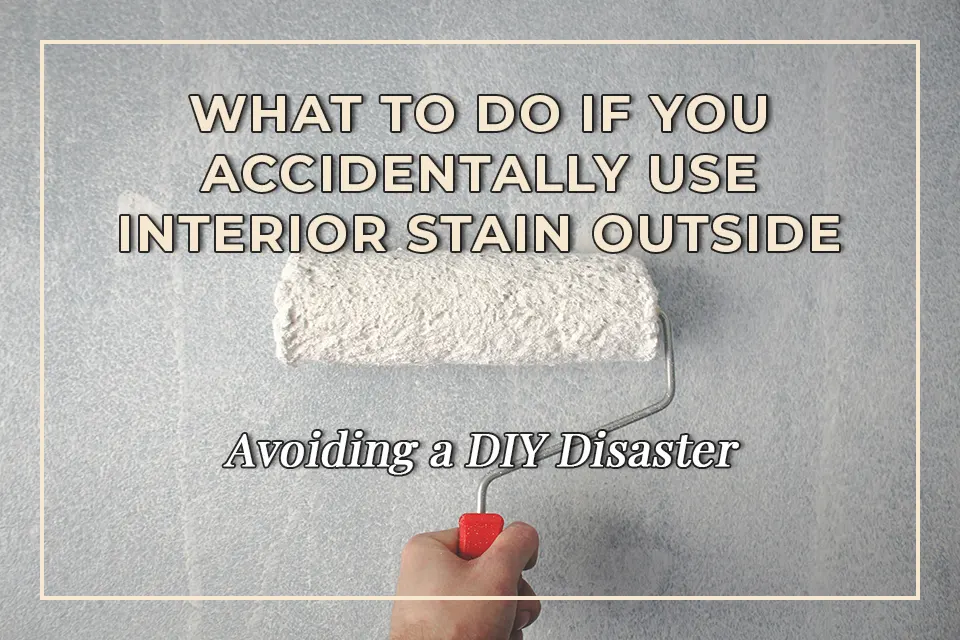
[ad_1]
Description: In this article, we will discuss what to do if you accidentally use interior stain outside. We will provide tips and solutions to help you avoid a DIY disaster and fix any mistakes that may occur.
What should you do if you accidentally use interior stain outside?
If you accidentally use interior stain outside, the first thing you should do is assess the situation. Take a look at the affected area and determine the extent of the damage. If the stain has only been applied to a small section, you may be able to remedy the situation with some simple fixes. However, if the stain has been used over a larger area, you may need to consider more extensive solutions.
Once you have assessed the situation, you can begin to take steps to fix the problem. One option is to try and sand away the stain if it is still wet. This may help to remove some of the color and reduce the impact of the mistake. If the stain has already dried, you may need to use a chemical stripper to remove it.
How can you prevent a DIY disaster when using interior stain?
To prevent a DIY disaster when using interior stain, it is important to carefully read the instructions on the product before you begin. Make sure that the stain is suitable for the surface you are working with, and that it is intended for outdoor use if you are staining an exterior area. It is also a good idea to test the stain on a small, inconspicuous area to ensure that it provides the desired result before applying it to a larger area.
Additionally, ensure that you are working in a well-ventilated area and that you are using the appropriate safety equipment, such as gloves and a mask, when applying the stain. By taking these precautions, you can minimize the risk of a DIY disaster and ensure a successful outcome.
What are some DIY solutions for fixing the mistake?
If you have accidentally used interior stain outside, there are a few DIY solutions that you can try to fix the mistake. One option is to use a wood brightener or deck cleaner to help lighten the color of the stain. This can be applied to the affected area and scrubbed with a brush to help reduce the appearance of the stain.
Another option is to consider applying a new coat of exterior stain or paint over the affected area. This can help to cover up the mistake and provide a fresh, new look to the surface. However, keep in mind that this may require additional preparation, such as sanding or priming, to ensure a smooth finish.
When should you consider seeking professional help?
If the DIY solutions for fixing the mistake are not providing the desired result, or if the damage is extensive, it may be time to consider seeking professional help. A professional contractor or painter can assess the situation and provide expert advice on the best course of action. They may have access to specialized tools and products that can help to effectively remove the stain and restore the surface to its original condition.
Additionally, if the stained surface is part of a larger project, such as a deck or fence, it may be beneficial to have a professional handle the entire refinishing process to ensure a high-quality, long-lasting result.
Conclusion
Mistakes happen, but with the right knowledge and approach, you can avoid a DIY disaster and fix any errors that occur. By taking the time to assess the situation, using DIY solutions to help remedy the mistake, and knowing when to seek professional help, you can ensure a successful outcome when using interior stain outside.
FAQs
Can I use interior stain outside?
No, interior stain is not designed for outdoor use. It is important to use the appropriate exterior stain for outdoor surfaces to ensure durability and long-lasting results.
What safety precautions should I take when using stain?
When using stain, it is important to work in a well-ventilated area and use appropriate safety equipment, such as gloves and a mask, to protect yourself from harmful fumes and chemicals.
Is it possible to remove the stain if it has already dried?
If the stain has dried, you may need to use a chemical stripper to help remove it. However, keep in mind that this process can be time-consuming and may require additional preparation and refinishing of the surface.
What type of surface preparation is needed before applying a new coat of stain or paint?
Before applying a new coat of stain or paint over the affected area, it is important to prepare the surface by sanding, cleaning, and possibly priming to ensure a smooth and long-lasting finish.
How do I know when it’s time to seek professional help?
If DIY solutions are not providing the desired result, or if the damage is extensive, it may be time to consider seeking professional help. A professional contractor or painter can assess the situation and provide expert advice on the best course of action.
[ad_2]
DIY Closet
5 Easy Steps to Cut Your Gutter Downspout Perfectly

[ad_1]
In this article, we will discuss 5 easy steps to cut your gutter downspout perfectly. Whether you are looking to replace an old downspout or customize a new one, cutting a downspout to the correct size is an essential part of the installation process. By following these simple steps, you can ensure that your gutter downspout fits perfectly and functions effectively.
What tools do I need to cut a gutter downspout?
To cut a gutter downspout, you will need a measuring tape, a marker, a hacksaw or tin snips, a file, and safety gloves. These are the basic tools required for achieving a clean and precise cut on your downspout. Make sure to work in a well-lit area and take necessary safety precautions when using sharp tools.
First, measure the length you need for your downspout and mark the cutting line using a marker. Use a measuring tape to ensure accurate measurements and a straight-line mark. Next, use a hacksaw or tin snips to cut along the marked line. Once the downspout is cut, use a file to smooth any rough edges and remove any burrs. Always wear safety gloves to protect your hands from sharp edges.
How do I ensure the downspout is cut to the correct length?
Before cutting the downspout, it is important to measure and mark the correct length. Use a measuring tape to determine the exact length required for your downspout and mark the cutting line with a marker. Double-check the measurements to ensure accuracy before making any cuts. Following these steps will help you ensure that the downspout is cut to the perfect length.
How can I make a straight and clean cut on the downspout?
To make a straight and clean cut on the downspout, use a hacksaw or tin snips to carefully cut along the marked line. Take your time and use a steady hand to ensure a precise cut. If using a hacksaw, use a miter box to guide the saw and keep the cut straight. If using tin snips, make small, controlled cuts to avoid jagged edges. After cutting, use a file to smooth any rough edges and remove any burrs, resulting in a clean and professional-looking cut.
How do I connect the downspout to the gutters and ground drainage system?
Once the downspout is cut to the correct length, you can connect it to the gutters and ground drainage system. If connecting to the gutters, use appropriate connectors to secure the downspout to the gutter system. Make sure the fit is secure and weatherproof to prevent any leaks or damage. If connecting to a ground drainage system, use a suitable elbow and extend the downspout to the desired location. Secure the downspout to the ground using straps or brackets to keep it in place and ensure effective water drainage.
How can I maintain and clean the downspout after cutting?
After cutting and installing the downspout, it is important to maintain and keep it clean to ensure optimal functioning. Regularly inspect the downspout for any debris or blockages and clear them out using a plumbing snake or pressure washer. Additionally, check for any signs of damage or corrosion and fix them promptly to prevent any issues with water drainage. By keeping the downspout clean and well-maintained, you can ensure it continues to work effectively for years to come.
Conclusion
Cutting a gutter downspout is a simple and essential part of the installation process. By following these 5 easy steps and using the right tools, you can cut your downspout perfectly and ensure it fits and functions as intended. Remember to measure and mark the correct length, make a straight and clean cut, and connect the downspout to the gutters and ground drainage system. With proper maintenance, your gutter downspout will continue to effectively direct water away from your home.
FAQs
Q: Can I use a regular saw to cut a gutter downspout?
A: While it is possible to use a regular saw to cut a gutter downspout, a hacksaw or tin snips are recommended for achieving a clean and precise cut. These tools are specifically designed for cutting metal and will result in a better finish.
Q: How do I prevent the downspout from getting clogged after cutting?
A: To prevent the downspout from getting clogged, regularly inspect and clean it to remove any debris or blockages. Consider installing gutter guards to prevent leaves and other debris from entering the downspout and causing clogs.
Q: Can I use duct tape to connect the downspout to the gutters?
A: Duct tape is not recommended for connecting the downspout to the gutters, as it may not provide a secure and weatherproof fit. Use appropriate connectors and sealants to ensure a strong and durable connection.
Q: What should I do if the downspout is too long after cutting?
A: If the downspout is too long after cutting, carefully trim it to the desired length using a hacksaw or tin snips. Remember to measure and double-check the length before making any cuts to avoid any mistakes.
Q: How often should I clean and maintain my gutter downspout?
A: It is recommended to clean and maintain your gutter downspout at least twice a year, especially before the rainy season and after the fall when leaves are more likely to accumulate. Regular maintenance will help prevent clogs and ensure proper water drainage.
[ad_2]
DIY Closet
Understanding the Causes of a Compressor Running with Equalized Pressures
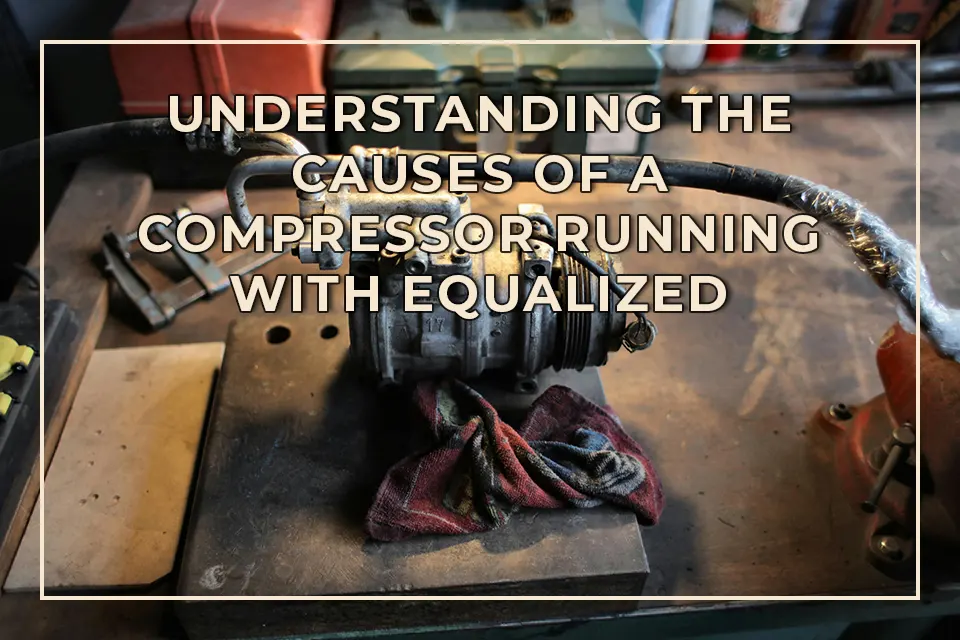
[ad_1]
In this article, we will discuss the common causes of a compressor running with equalized pressures. We will explore the different factors that can lead to this issue and provide some tips for troubleshooting and resolving the problem.
What are the Causes of a Compressor Running with Equalized Pressures?
When a compressor is running with equalized pressures, it means that the pressure on the suction and discharge sides of the compressor is the same. This can lead to a loss of cooling capacity and increased energy consumption. There are several potential causes of this issue, including:
1. Faulty check valve: The check valve is responsible for preventing the backflow of refrigerant into the compressor. If the check valve is faulty or stuck open, it can lead to equalized pressures and reduced efficiency.
2. Refrigerant leak: A refrigerant leak can cause the pressures on the suction and discharge sides of the compressor to equalize. This can be caused by a damaged or worn-out seal, loose fittings, or corrosion on the compressor components.
3. Restricted refrigerant flow: If there is a restriction in the refrigerant flow, such as a clogged filter drier or expansion valve, it can cause the pressures to equalize and impact the performance of the compressor.
How to Troubleshoot a Compressor Running with Equalized Pressures?
If you suspect that your compressor is running with equalized pressures, there are a few steps you can take to troubleshoot the issue:
1. Check the check valve: Inspect the check valve for any signs of damage or wear. If the check valve is faulty, it will need to be replaced to restore proper compressor operation.
2. Inspect for refrigerant leaks: Use a refrigerant leak detector to check for any leaks in the system. Repair any leaks that are identified and recharge the system with the correct amount of refrigerant.
3. Check for restrictions in the refrigerant flow: Inspect the filter drier and expansion valve for any signs of clogging or restriction. Clean or replace these components as needed to restore proper refrigerant flow.
Conclusion
In conclusion, a compressor running with equalized pressures can be caused by a faulty check valve, refrigerant leak, or restricted refrigerant flow. By troubleshooting these potential causes and making the necessary repairs, you can restore the proper operation of your compressor and ensure optimal cooling capacity.
FAQs
Q: Can a compressor running with equalized pressures be fixed without professional help?
A: Yes, in many cases, troubleshooting and resolving the causes of a compressor running with equalized pressures can be done without professional help. However, if you are unsure or uncomfortable working on your compressor, it is always best to seek the assistance of a qualified technician.
Q: How can I prevent a compressor from running with equalized pressures in the future?
A: Regular maintenance, including checking for leaks and ensuring proper refrigerant flow, can help prevent a compressor from running with equalized pressures. Additionally, following manufacturer recommendations for maintenance and operation can also help prevent this issue.
Q: Is it safe to continue using a compressor that is running with equalized pressures?
A: While it may be possible to continue using a compressor with equalized pressures, it is not recommended. This can lead to reduced cooling capacity, increased energy consumption, and potential damage to the compressor. It is best to address the issue as soon as possible to prevent further problems.
Q: How often should I check my compressor for equalized pressures?
A: It is a good idea to include compressor checks in your regular maintenance routine, at least once or twice a year. Additionally, if you notice any changes in the performance of your compressor, such as reduced cooling capacity or unusual noises, it is a good idea to check for equalized pressures.
Q: What should I do if I cannot identify the cause of a compressor running with equalized pressures?
A: If you are unable to identify the cause of a compressor running with equalized pressures, it is best to consult with a qualified technician. They can perform a thorough inspection and diagnostic to identify the underlying issue and recommend the appropriate course of action.
[ad_2]

 DIY Closet3 months ago
DIY Closet3 months agoHow to Install a Drop-In Sink Without Clips: A Step-by-Step Guide

 DIY Closet3 months ago
DIY Closet3 months agoUnderstanding the Benefits of a 400 Amp Meter Base with Two 200 Amp Disconnects

 DIY Closet3 months ago
DIY Closet3 months agoUnderstanding the Importance and Benefits of UL 2 Hour Fire Rated Wall Assemblies

 DIY Closet3 months ago
DIY Closet3 months agoThe Importance of P-Traps in Bathtubs: What You Need to Know

 DIY Closet4 months ago
DIY Closet4 months agoE3 Spark Plugs vs NGK: Which is the Better Choice for Your Vehicle?

 DIY Closet3 months ago
DIY Closet3 months agoHow to Properly Store Paint Mixed with Floetrol for Longevity

 DIY Closet3 months ago
DIY Closet3 months agoIs Your Korky Toilet Flapper Closing Too Fast? Here’s What You Need to Know

 DIY Closet4 months ago
DIY Closet4 months agoHow to Build a Free Standing 6×6 Post Swing Set: A Step-by-Step Guide











